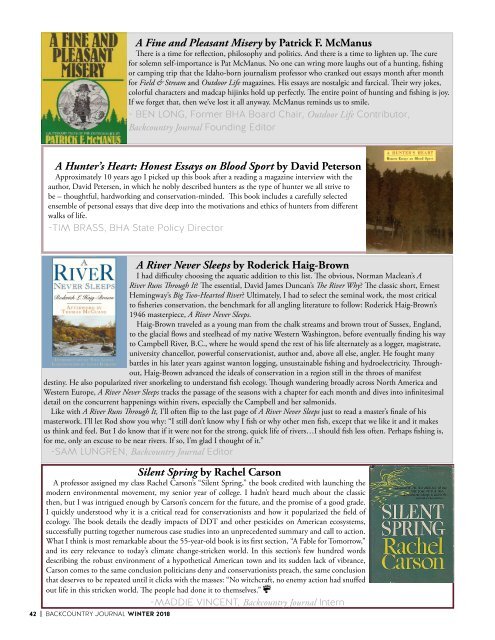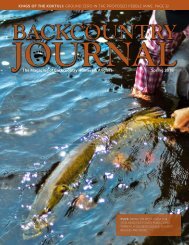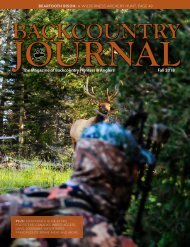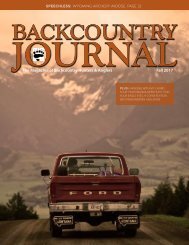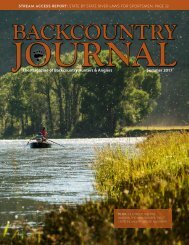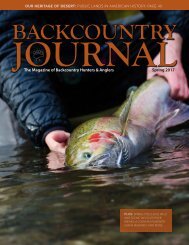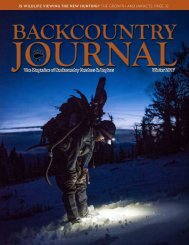BCJ_WINTER18 Digital Edition
You also want an ePaper? Increase the reach of your titles
YUMPU automatically turns print PDFs into web optimized ePapers that Google loves.
A Fine and Pleasant Misery by Patrick F. McManus<br />
There is a time for reflection, philosophy and politics. And there is a time to lighten up. The cure<br />
for solemn self-importance is Pat McManus. No one can wring more laughs out of a hunting, fishing<br />
or camping trip that the Idaho-born journalism professor who cranked out essays month after month<br />
for Field & Stream and Outdoor Life magazines. His essays are nostalgic and farcical. Their wry jokes,<br />
colorful characters and madcap hijinks hold up perfectly. The entire point of hunting and fishing is joy.<br />
If we forget that, then we’ve lost it all anyway. McManus reminds us to smile.<br />
- BEN LONG, Former BHA Board Chair, Outdoor Life Contributor,<br />
Backcountry Journal Founding Editor<br />
A Hunter’s Heart: Honest Essays on Blood Sport by David Peterson<br />
Approximately 10 years ago I picked up this book after a reading a magazine interview with the<br />
author, David Petersen, in which he nobly described hunters as the type of hunter we all strive to<br />
be – thoughtful, hardworking and conservation-minded. This book includes a carefully selected<br />
ensemble of personal essays that dive deep into the motivations and ethics of hunters from different<br />
walks of life.<br />
-TIM BRASS, BHA State Policy Director<br />
A River Never Sleeps by Roderick Haig-Brown<br />
I had difficulty choosing the aquatic addition to this list. The obvious, Norman Maclean’s A<br />
River Runs Through It? The essential, David James Duncan’s The River Why? The classic short, Ernest<br />
Hemingway’s Big Two-Hearted River? Ultimately, I had to select the seminal work, the most critical<br />
to fisheries conservation, the benchmark for all angling literature to follow: Roderick Haig-Brown’s<br />
1946 masterpiece, A River Never Sleeps.<br />
Haig-Brown traveled as a young man from the chalk streams and brown trout of Sussex, England,<br />
to the glacial flows and steelhead of my native Western Washington, before eventually finding his way<br />
to Campbell River, B.C., where he would spend the rest of his life alternately as a logger, magistrate,<br />
university chancellor, powerful conservationist, author and, above all else, angler. He fought many<br />
battles in his later years against wanton logging, unsustainable fishing and hydroelectricity. Throughout,<br />
Haig-Brown advanced the ideals of conservation in a region still in the throes of manifest<br />
destiny. He also popularized river snorkeling to understand fish ecology. Though wandering broadly across North America and<br />
Western Europe, A River Never Sleeps tracks the passage of the seasons with a chapter for each month and dives into infinitesimal<br />
detail on the concurrent happenings within rivers, especially the Campbell and her salmonids.<br />
Like with A River Runs Through It, I’ll often flip to the last page of A River Never Sleeps just to read a master’s finale of his<br />
masterwork. I’ll let Rod show you why: “I still don’t know why I fish or why other men fish, except that we like it and it makes<br />
us think and feel. But I do know that if it were not for the strong, quick life of rivers…I should fish less often. Perhaps fishing is,<br />
for me, only an excuse to be near rivers. If so, I’m glad I thought of it.”<br />
-SAM LUNGREN, Backcountry Journal Editor<br />
Silent Spring by Rachel Carson<br />
A professor assigned my class Rachel Carson’s “Silent Spring,” the book credited with launching the<br />
modern environmental movement, my senior year of college. I hadn’t heard much about the classic<br />
then, but I was intrigued enough by Carson’s concern for the future, and the promise of a good grade.<br />
I quickly understood why it is a critical read for conservationists and how it popularized the field of<br />
ecology. The book details the deadly impacts of DDT and other pesticides on American ecosystems,<br />
successfully putting together numerous case studies into an unprecedented summary and call to action.<br />
What I think is most remarkable about the 55-year-old book is its first section, “A Fable for Tomorrow,”<br />
and its eery relevance to today’s climate change-stricken world. In this section’s few hundred words<br />
describing the robust environment of a hypothetical American town and its sudden lack of vibrance,<br />
Carson comes to the same conclusion politicians deny and conservationists preach, the same conclusion<br />
that deserves to be repeated until it clicks with the masses: “No witchcraft, no enemy action had snuffed<br />
out life in this stricken world. The people had done it to themselves.”<br />
-MADDIE VINCENT, Backcountry Journal Intern<br />
42 | BACKCOUNTRY JOURNAL WINTER 2018


